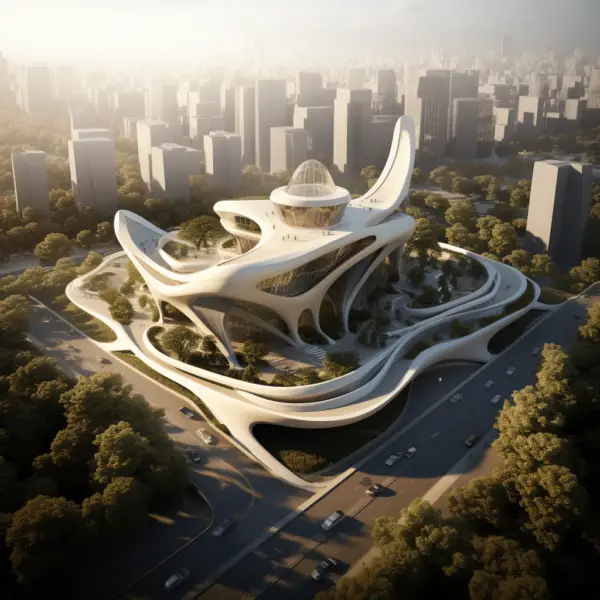Successful Architecture: US Opportunities And Growth Trends
Architects have promising career prospects in the United States, with a projected growth rate of 7% from 2014 to 2024. The architectural industry offers a diverse range of opportunities, including residential and commercial design, urban planning, and green design. Architects in the United States, To succeed in this field, architects need a comprehensive set of skills, such as analytical, mathematical, creative, organizational, visual, technical, and communicative capabilities. They must also be able to blend form with function, understand engineering principles, and have spatial relation skills. Collaboration and communication skills are crucial as architects work closely with clients, contractors, and other professionals.
Key Takeaways:
- The projected growth rate for architects in the United States is 7% from 2014 to 2024.
- The median salary for architects is around $76,000 with a 1.9% unemployment rate.
- Architects have a diverse range of career options, including residential and commercial design, urban planning, and green design.
- Skills required for architectural success include analytical, mathematical, creative, organizational, visual, technical, and communicative capabilities.
- Architects must be able to blend form with function, understand engineering principles, and have spatial relation skills.
Growth and Salary Data for Architects

The architectural industry offers a promising growth rate of 7% and a median salary of approximately $76,000 for architects in the United States. These figures, coupled with a 1.9% unemployment rate, indicate a stable and lucrative career path in this field. Architects in the United States, Architects play a pivotal role in designing and creating spaces that are both aesthetically pleasing and functional, contributing to the growth of the industry.
The projected growth rate of 7% from 2014 to 2024 presents ample opportunity for architects to advance their careers. This growth is driven by increased demand for new construction, renovations, and sustainable design practices. As architects continue to innovate and adapt to evolving trends, they can expect to see a rise in job opportunities and job security.
In addition to the promising growth rate, architects enjoy a median salary of around $76,000, making it an attractive profession from a financial standpoint. This figure may vary based on experience, location, and specialization within the field. Architects who demonstrate expertise in high-demand areas such as sustainable design or commercial architecture may command higher salaries.
| Growth Rate | Median Salary | Unemployment Rate |
|---|---|---|
| 7% | $76,000 | 1.9% |
Overall, the architectural industry offers promising growth and substantial earning potential for architects. With the right combination of skills, expertise, and experience, architects can thrive in this dynamic and rewarding field.
Diverse Career Options for Architects
Architects have a wide range of career options in the United States, including residential and commercial design, urban planning, and green design. This industry offers architects the opportunity to create innovative and sustainable structures that shape the world we live in. Whether designing homes, office buildings, or entire cities, architects play a vital role in shaping our built environment.
In residential design, architects work closely with clients to create functional and aesthetically pleasing homes. They take into account factors such as space utilization, building codes, and client preferences to design custom living spaces. From cozy bungalows to luxurious mansions, residential design allows architects to showcase their creativity and create dream homes for individuals and families.
On the other hand, commercial design focuses on creating spaces for businesses and organizations. Architects working in this field design office buildings, retail spaces, hotels, and other commercial structures. They consider factors such as efficiency, functionality, and branding to optimize the space for the specific needs of businesses. Commercial architects have the opportunity to design iconic structures that become landmarks in urban landscapes.
Urban planning is another exciting career option for architects. In this field, architects collaborate with urban planners, policymakers, and communities to create sustainable and vibrant cities. They design public spaces, transportation systems, and infrastructure that enhance the quality of life for residents. Urban planners consider factors such as population growth, environmental impact, and social equity to develop holistic urban designs.
Table: A Snapshot of Diverse Career Options for Architects
| Career Pathway | Description |
|---|---|
| Residential Design | Creating custom living spaces that meet the needs and desires of homeowners |
| Commercial Design | Designing functional and visually appealing spaces for businesses and organizations |
| Urban Planning | Collaborating with experts to design sustainable and livable cities |
| Green Design | Developing environmentally friendly and energy-efficient structures |
Lastly, green design is an emerging field that focuses on creating sustainable and energy-efficient structures. Architects specializing in green design incorporate environmentally friendly materials, renewable energy systems, and passive design strategies into their projects. Architects in the United States, They play a crucial role in reducing the carbon footprint of buildings and creating a more sustainable future.
Overall, the diverse career options available to architects in the United States provide exciting opportunities for professional growth and creativity. Whether designing residential spaces, commercial buildings, urban landscapes, or sustainable structures, architects have the power to shape the world we live in.
Skills Required for Architectural Success
Architects must possess a wide range of skills, including analytical, mathematical, creative, organizational, visual, technical, and communicative capabilities. These skills are essential for success in the field, as architects are responsible for designing and constructing buildings that meet the needs of their clients while also adhering to safety regulations and aesthetic principles.
Analytical skills are crucial for architects, as they must be able to analyze and interpret complex information and data to develop innovative design solutions. Mathematical skills are also essential for architects, as they are often required to calculate measurements, proportions, and structural loads.
| Skill | Description |
|---|---|
| Analytical Skills | Ability to analyze and interpret complex information and data. |
| Mathematical Skills | Proficiency in calculating measurements, proportions, and structural loads. |
| Creative Abilities | Capacity to think creatively and develop innovative design solutions. |
| Organizational Skills | Capability to manage multiple projects and deadlines. |
| Visual Skills | Expertise in creating visually appealing and functional designs. |
| Technical Skills | Proficiency in architectural software and knowledge of building codes and construction techniques. |
| Communicative Skills | Ability to effectively communicate with clients, contractors, and other professionals. |
These skills are not only vital for executing architectural projects successfully but also for staying competitive in a constantly evolving industry. Architects who possess a strong skill set are more likely to attract clients, collaborate effectively with other professionals, and achieve career advancement.
“Architects must possess a wide range of skills, including analytical, mathematical, creative, organizational, visual, technical, and communicative capabilities.”
Blending Form and Function
Architects play a crucial role in blending form and function in their designs, considering both aesthetic appeal and practicality, while also understanding engineering principles and spatial relations. They strive to create structures that not only look visually pleasing but also serve their intended purpose effectively.
When designing a building or space, architects take into account various factors, such as the intended use, the surrounding environment, and the needs of the people who will interact with the structure. They ensure that the design not only looks beautiful but also meets the functional requirements of the client and enhances the overall user experience.
By understanding engineering principles, architects can ensure that their designs are structurally sound and meet safety standards. They consider factors such as load-bearing capacities, material properties, and building codes to create designs that can withstand the test of time. Additionally, architects with spatial relation skills can optimize the use of space, ensuring efficient layouts and smooth navigation within a building or environment.
Table: Examples of Architectural Designs Blending Form and Function
| Building | Description |
|---|---|
| Frank Lloyd Wright’s Fallingwater | A residential house built over a waterfall, seamlessly integrating nature and architecture. |
| One World Trade Center | Combines a striking architectural design with state-of-the-art technology and safety features. |
| Beijing National Stadium (Bird’s Nest) | A visually captivating structure that served as the main venue for the 2008 Olympic Games. |
Architects achieve this blending of form and function through a combination of artistic vision, technical knowledge, and a deep understanding of the needs and desires of their clients. By striking the right balance between aesthetics and usability, architects create designs that not only stand out visually but also provide practical and functional spaces for people to live, work, and play.
Collaboration and Communication Skills
Collaboration and communication skills are essential for architects to effectively work with clients, contractors, and other professionals in the industry. Architects must be able to communicate their ideas clearly and concisely, both verbally and in writing. This includes explaining design concepts to clients, presenting proposals to project stakeholders, and providing instructions to contractors during the construction process.
Effective collaboration is also vital for architects, as they often work as part of a team that includes engineers, interior designers, and other specialists. Architects need to be able to collaborate seamlessly with these professionals, sharing ideas and integrating their expertise into the overall design. This collaboration ensures that all aspects of a project are cohesive and functional.
Architects can benefit from using collaborative tools and software to streamline communication and enhance collaboration. Project management platforms, virtual design software, and cloud-based document sharing can facilitate real-time collaboration and ensure that everyone involved in a project remains on the same page.
Benefits of Collaboration and Communication Skills in Architecture
- Improved project outcomes: Architects in the United States, Effective collaboration and communication lead to better project outcomes by ensuring that all stakeholders are aligned, reducing errors and misunderstandings.
- Enhanced client relationships: Strong communication skills enable architects to build trust and rapport with clients, ensuring their needs and expectations are met throughout the design and construction process.
- Increased efficiency: Collaboration tools streamline communication and enable architects to work more efficiently with team members, saving time and reducing delays.
- Greater creativity: Collaboration fosters the exchange of ideas and perspectives, leading to innovative and creative design solutions that can set architects apart from their peers.
Effective collaboration and communication are the cornerstones of architectural success. Architects who possess these skills can navigate the complex web of stakeholders, deliver exceptional design solutions, and build lasting relationships in the industry.
Table: Key Collaboration and Communication Skills for Architects
| Collaboration Skills | Communication Skills |
|---|---|
| Active listening | Clear and concise verbal communication |
| Teamwork and cooperation | Effective written communication |
| Conflict resolution | Visual communication (sketching, rendering) |
| Flexibility and adaptability | Presenting and public speaking |
| Problem-solving | Client relationship management |
Technological Advancements in Architecture
Technological advancements in architecture, particularly in software, have significantly increased productivity for architects, streamlining design processes. The use of advanced software tools has revolutionized the way architects conceptualize, visualize, and communicate their ideas. This has led to greater efficiency, accuracy, and creativity in architectural design.
One of the major advancements in architecture software is the development of computer-aided design (CAD) programs. These powerful tools allow architects to create precise and detailed 2D and 3D models of their designs, enabling them to better understand spatial relationships and identify any potential issues before construction begins. CAD software also offers a wide range of features and functionalities, including the ability to generate accurate construction drawings, create realistic renderings, and even simulate lighting and materials.
With the help of architectural software, we are able to bring our visions to life in a more efficient and effective way. The level of detail and accuracy that can be achieved with these tools is truly remarkable. It not only saves us time and resources, but also allows us to explore new design possibilities that were previously unimaginable.
Architects in the United States, Building information modeling (BIM) software is another architectural innovation. BIM lets architects generate sophisticated 3D models with geometry and architectural component and system information. This integrated approach lets architects, engineers, and contractors collaborate on a single model. BIM software improves cost estimation, clash identification, and project scheduling, improving project outcomes.
The Impact of Technological Advancements
Architecture has been greatly impacted by technology. These advances have increased architect productivity and design quality and precision. More complicated and imaginative designs, easier iterations, and more engaging and interactive presentations are now possible for architects. These advances have also increased architect and design and construction professional collaboration and communication.
| Advantages of Technological Advancements in Architecture | Disadvantages of Technological Advancements in Architecture |
|---|---|
|
|
Overall, technological advancements in architecture have opened up new possibilities and transformed the way architects work. By leveraging the power of advanced software tools, architects are able to bring their visions to life with greater efficiency, accuracy, and creativity.
Specializing in Sustainable Design
Since demand for eco-friendly design solutions is rising, sustainable design architects have an advantage in the employment market. Architects in the United States, With the growing emphasis on sustainability and green practices, clients and companies want architects with these skills.
Sustainable design reduces the environmental impact of structures throughout their existence. This comprises energy-efficient systems, renewable materials, and waste- and carbon-reduction techniques. Designers of energy-efficient and ecologically friendly buildings can save clients money and benefit the environment.
Understanding green construction principles, sustainable materials, and renewable energy sources is essential for sustainable design expertise. Architects with this understanding may assist clients choose sustainable choices and meet their environmental goals. Sustainable design architects have additional career options because many corporations and organizations are actively recruiting sustainability experts.
Benefits of Specializing in Sustainable Design
- High demand in the job market
- Opportunities for innovation and creativity
- Contribution to a more sustainable future
- Potential for higher earnings
Table: Growth in Sustainable Design
| Year | Growth Rate |
|---|---|
| 2014 | 15% |
| 2015 | 18% |
| 2016 | 21% |
As the demand for sustainable design continues to grow, architects who specialize in this field can look forward to a rewarding and fulfilling career. By embracing sustainable practices, architects have the opportunity to make a positive impact on the environment while also advancing their professional development and success in the industry.
Architectural Career Pathways
The field of architecture offers various career pathways, including urban planning, residential and commercial design, landscape architecture, and green design. Architects have the opportunity to shape the world around them through thoughtful and innovative design solutions. Whether working on large-scale urban development projects or creating sustainable residential homes, architects play a vital role in enhancing the built environment.
Urban Planning
Architects specializing in urban planning collaborate with government agencies, developers, and communities to create sustainable and livable cities. They design master plans that consider factors such as zoning regulations, transportation systems, and public spaces. Urban planners work to ensure that cities are functional, aesthetically pleasing, and responsive to the needs of the people who inhabit them.
Residential and Commercial Design
Architects who specialize in residential and commercial design create spaces that are both functional and visually appealing. They work closely with clients to understand their requirements and translate them into architectural designs. These architects consider factors such as layout, materials, and building codes to create spaces that meet the needs of the occupants while adhering to safety and regulatory standards.
Landscape Architecture and Green Design
Architects with a passion for the natural environment often pursue careers in landscape architecture and green design. They create outdoor spaces that harmonize with their surroundings and incorporate sustainable design principles. These architects design parks, gardens, and other outdoor areas that prioritize environmental conservation and enhance the overall well-being of communities.
| Career Pathway | Description | Skills Required |
|---|---|---|
| Urban Planning | Collaborate with government agencies, developers, and communities to create sustainable and livable cities. | Strong analytical and problem-solving skills, knowledge of urban development principles, ability to work collaboratively |
| Residential and Commercial Design | Create functional and visually appealing spaces for residential and commercial purposes. | Excellent design and visualization skills, knowledge of building codes and regulations, ability to communicate effectively with clients |
| Landscape Architecture and Green Design | Create outdoor spaces that prioritize environmental conservation and enhance the well-being of communities. | Understanding of ecological systems, creative design abilities, knowledge of sustainable design principles |
These career pathways are just a glimpse into the possibilities available to architects. The field of architecture is vast and offers opportunities for specialization in various areas, such as commercial architecture, interior design, historic preservation, and more. Architects can choose to work in private firms, government agencies, or start their own practices. With their unique combination of artistic vision and technical expertise, architects have the ability to make a lasting impact on the world we live in.
Growth and Opportunities in Commercial Architecture

Commercial architecture offers US architects job advancement and opportunity. With the growing commercial sector, architects who can design innovative and practical environments for businesses and organizations are in demand.
The Bureau of Labor Statistics predicts 7% growth for architects from 2014 to 2024, faster than the average for all occupations. Renovating, building, and improving building efficiency and sustainability drives this increase. Commercial architects should expect a continuous stream of projects and a good work market.
In addition to expansion, commercial architecture offers architects several opportunity to display their abilities and creativity. Architectural projects range from office buildings and retail areas to hotels and restaurants, shaping the urban landscape. The commercial sector allows architects to collaborate alongside engineers, interior designers, and contractors, improving their teamwork and communication abilities.
Table: Top 5 Commercial Architecture Projects in the US
| Project Name | Type | Location |
|---|---|---|
| One World Trade Center | Office Building | New York, NY |
| Hudson Yards | Mixed-Use Development | New York, NY |
| Amazon HQ2 | Corporate Campus | Various Locations |
| Apple Park | Corporate Campus | Cupertino, CA |
| The Oculus | Transportation Hub | New York, NY |
The field of commercial architecture offers architects promising growth prospects and exciting career opportunities. With the projected growth rate and the diverse range of projects available, architects specializing in commercial design can make a significant impact on the built environment while enjoying a fulfilling and rewarding career.
Conclusion
In the US, architects have several professional alternatives, a demand for critical skills, and room for growth and specialization.
From 2014 to 2024, the architecture sector is expected to rise 7%. This expansion gives architects more chances to follow their dreams and succeed. The typical architect salary of $76,000 and the low unemployment rate of 1.9% demonstrate their financial stability and job security.
The architecture sector offers many alternatives. From residential and commercial design to urban planning and green design, architects can follow their passions. This diversity allows architects to be creative and build lively, sustainable communities.
FAQ
Q: What are the career prospects for architects?
A: The career prospects for architects are promising, with a projected growth rate of 7% from 2014 to 2024. Architects have a diverse range of options in this industry, including residential and commercial design, urban planning, and green design.
Q: What is the median salary for architects?
A: The median salary for architects is around $76,000.
Q: What is the unemployment rate for architects?
A: The unemployment rate for architects is 1.9%.
Q: What skills are required to succeed as an architect?
A: Architects need a comprehensive set of skills, including analytical, mathematical, creative, organizational, visual, technical, and communicative capabilities. They must also have an understanding of engineering principles and spatial relation skills.
Q: How important are collaboration and communication skills for architects?
A: Collaboration and communication skills are crucial for success in the field of architecture. Architects must work closely with clients, contractors, and other professionals to bring their designs to life.
Q: How have technological advancements impacted the architecture industry?
A: Technological advancements, particularly in software, have increased productivity for architects. These advancements have allowed for more efficient design processes.
Q: What are the benefits of specializing in sustainable design?
A: Specializing in sustainable design gives architects an edge in the job market. There is a growing demand for environmentally-friendly design solutions, and architects with expertise in sustainable design are well-positioned to meet this demand.
Q: What are the different career pathways in architecture?
A: Architects have a range of career pathways to choose from, including urban planning, residential and commercial design, landscape architecture, commercial architecture, and green design.








